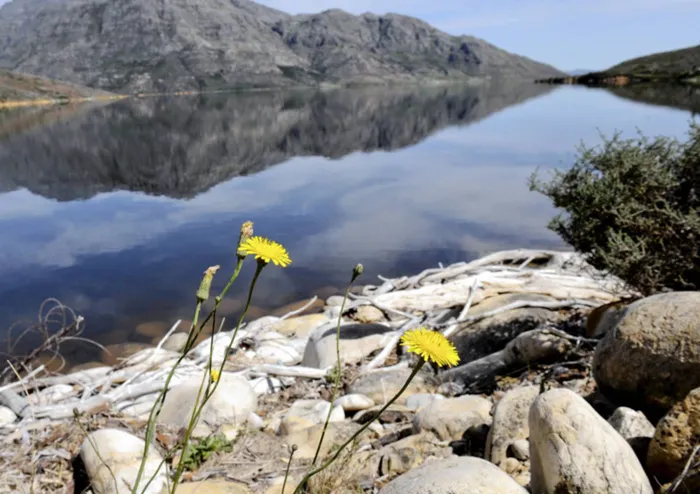The invisible killers in our water

WWF JOURNEY OF WATER, 2013/11/07, World Wildlife Fund Journey of Water to raise awareness of water. The Berg River Dam is a 68-metre (223 ft) high dam on the Berg River in South Africa. Picture: Adrian de Kock WWF JOURNEY OF WATER, 2013/11/07, World Wildlife Fund Journey of Water to raise awareness of water. The Berg River Dam is a 68-metre (223 ft) high dam on the Berg River in South Africa. Picture: Adrian de Kock
Johannesburg - It’s what scientists call a slow disaster, like a leaky tap that trickles so imperceptibly you don’t notice the meter going up.
Dr Jo Barnes, lecturer in epidemiology and community health at Stellenbosch University, says she realised we were facing a health crisis because of high levels of pollution and sewage in our water back in 1998. The required action is yet to be taken.
“It has the unique component that by the time you realise you have a disaster on your hands, you are already in it,” says Barnes.
Idyllic Stellenbosch provides a case study of South Africa’s water scenario. From the source of the Berg River just a few kilometres out of town to where the Eerste River flows through Stellenbosch, the e-coli count rises from 14/100ml to 34 million/100ml. This is more than 8 000 times the safe drinking level.
Barnes says the problem is largely a sewage problem. Sewage comes into the system through leaking pipes, stormwater drains and dumping of toilets in informal settlements, along with badly treated waste water.
With lack of infrastructure, the problem is getting progressively worse. Existing systems have not been upgraded to cope with the increase in our population. Stellenbosch residents say on a busy weekend you can see the waste water overflowing in the local treatment plant.
In the dry season when natural water levels are low, parts of the Eerste River can be 80 percent sewerage effluent. In the past, houses along the river had to be evacuated because the river was not safe. Some farmers struggle to export their crops because they are grown with contaminated water.
“Farmers are not compliant with standards and the EU is already aware of the problem,” says Charon Marais, PhD researcher at Stellenbosch University Business School. Even eating a green salad can be dangerous when it has been irrigated with dirty water.
And the sea isn’t a delete button on these problems. Barnes says many bacteria can enter the gut of fish and mussels and come back through the food chain. “We are not exempt just because it’s pretty around here.”
Last year the Green Drop Report, a Department of Water initiative which rates waste water treatment plants, found that 39 percent of plants had worsened in their ability to treat sewage while 73 percent were at some risk, and 44 percent were either at high or critical risk levels.
Treated waste water is always fed back into rivers or directly into the ocean. When there is a heavy week, sewage may go through the plant too quickly and come out the other side only partially treated.
At Zandvliet Waste Water Treatment Facility in Cape Town they function at capacity, despite being considered a low-risk plant. Michael Toll, head of operations for the Waste Water Department of the City of Cape Town, said Zandvliet needs two extensions that will cost R500 million.
However, there is no divert function to another plant when there is too much waste coming through. They also cannot divert waste when maintenance needs to be done.
“Unfortunately waste water has been the black sheep of the family when it came to funds,” says Toll. “We are battling to keep up with the development. Stormwater comes into the system and puts unnecessary strain on it. It washes out bacteria meant to be treating waste.”
Treating waste water can be complex, particularly with varying levels of toxins coming through on different days. Toll says they struggle to find people with the technical skills to manage this correctly.
The effects of all of this for health may seem invisible but they are being felt around the country. Polluted water can carry hepatitis, respiratory illnesses, polio and heart viruses. Earlier this year a study by the Water Research Commission found that antiretrovirals, detergents, mood stabilisers and pesticides were coming through in our drinking water. The study said that although these emerging contaminants were not directly harming health at present, there was concern over their potential effects.
One of the most common effects is the seemingly mundane diarrhoea. In South Africa this disease is the third leading cause of death in children under five, and the seventh leading cause of death in adults.
“About 80 percent of these deaths could be prevented if you had water hygiene that was up to standard,” says Bettina Genthe, senior researcher of Water Eco Systems and Human Health Research Group at the CSIR.
It’s often the poor, the old and the HIV-positive who are most vulnerable, but even in the “healthy” population, people often do not realise they are getting sick more often than they should be. Genthe says in some communities it is considered normal to have 10 incidents of diarrhoea a year.
Barnes said a majority of households in informal settlements reported at least one family member with diarrhoea in a two-week period.
Genthe says the cost of ignoring the high incidence of diarrhoea is 35 times what it would cost to prevent it. On an individual basis, taking so much sick time could lead to an inability to work or to support oneself.
“People kind of ignore it, it’s a nuisance, but it actually has huge impacts,” says Genthe. - The Star